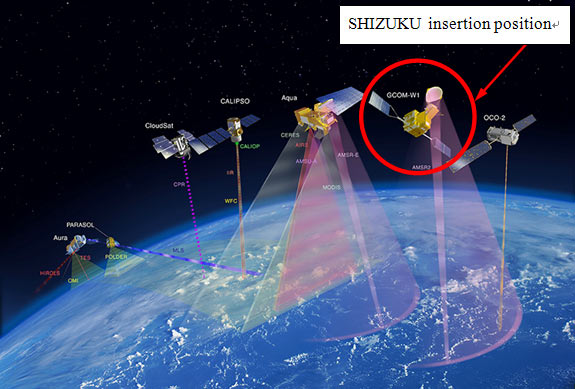Global Change Observation Mission 1st - Water 'SHIZUKU' (GCOM-W1) Inserted into A-Train Orbit
Japan Aerospace Exploration Agency (JAXA)
The Japan Aerospace Exploration Agency (JAXA) confirmed that the Global Change Observation Mission 1st - Water "SHIZUKU" (GCOM-W1) was inserted into a planned position on the A-Train orbit as a result of orbit control performed on June 29, 2012. The SHIZUKU was launched from the Tanegashima Space Center at 1:39 a.m. on May 18, 2012 (Japan Standard Time).
The SHIZUKU is flying in front of the Aqua satellite, thus it takes the most front position in the A-Train until another National Aeronautics and Space Administration (NASA) satellite, OCO-2 (USA) joins the constellation.
We have received a welcome message from Dr. Michael Freilich, Earth Science Division Director, of the NASA, as follows: "We are pleased to welcome JAXA and SHIZUKU as a member of the international A-Train constellation. The merging and sharing of data from multiple A-Train satellites has already led to significant advances in atmospheric science, and the addition of the Advanced Microwave Scanning Radiometer 2 (AMSR2) dataset will be an important extension of the A-Train's scientific capabilities."
JAXA will increase the rotation speed of the AMSR2 aboard the SHIZUKU from the lower rotation mode (11 rpm) to the regular observation mode of 40 rpm to verify its observation performance.

Outline of A-Train (The Afternoon Constellation)
The Afternoon Constellation, or the "A-Train", is an Earth observation satellite constellation run by NASA, and consists of multiple satellites orbiting the Earth in close proximity at an altitude of about 700km, crossing the equator at around 1:30 p.m. local mean solar time. This system allows satellites from various countries to cooperate in earth observations. Currently, with the A-train, the following satellites are participating: Aqua (NASA, U.S.A.), CloudSat (NASA, U.S.A), CALIPSO (NASA, U.S.A./ CNES, France), Aura (NASA, U.S.A.) and Japan has participated in the system for the first time with the SHIZUKU.
Special Features of the A-Train
For Earth observation, it is very efficient to perform observations by measuring the same one location with various sensors at the same time. With various satellites lining up on the almost same orbit, the A-Train enables us to observe the same location on the Earth by multiple satellites around the same time (approximately within 10 minutes.) The position of each satellite is strictly controlled; therefore, a new comer has to be injected into a pre-determined location that does not interfere with other already-flying members. The SHIZUKU entered the A-Train orbit successfully by utilizing JAXA's rendezvous technology. It is the first experience for JAXA to operate a satellite in the constellation flying on the almost same orbit.
|
|
(Reference) A-Train (Satellite constellation) member satellites
- Aura (NASA, USA) launched on July 15, 2004)
To acquire observation data for elucidating the composition of the earth atmosphere, its chemical react, and dynamics. - CALIPSO (NASA/CNES, USA/France) launched on April 28 2006)
An optical lidar satellite to acquire observation data to clarify impact of aerosol and clouds on the Earth's climate - CloudSat (NASA, USA launched on April 28, 2006)
A radio wave radar satellite to acquire observation data to study the impact of clouds on the Earth's climate - Aqua (NASA, USA launched on May 4, 2002)
The name came from the Latin word "Aqua" meaning water. The satellite acquires observation data on the Earth's various water circulations including water vapor in the atmosphere and from the ocean, clouds, precipitation, ocean ice, and ground water.